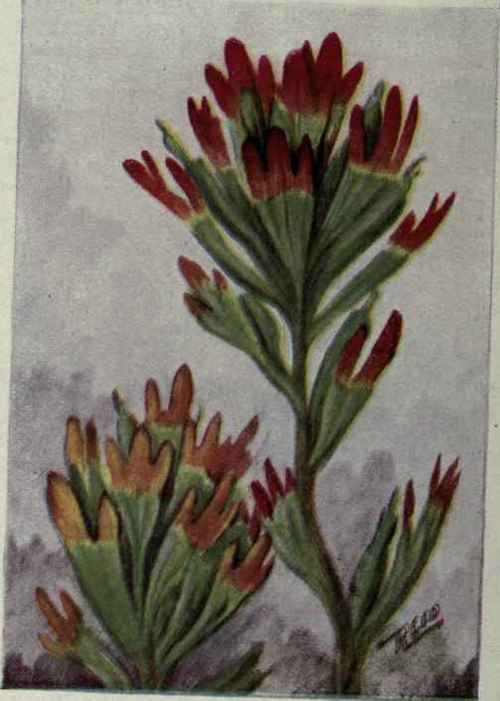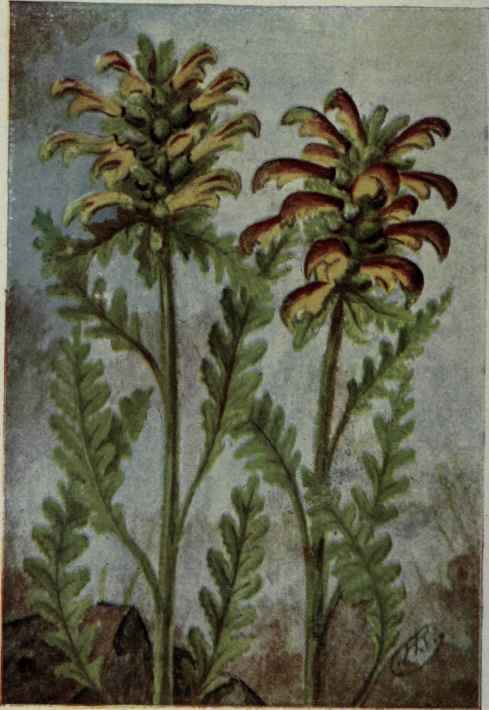Figwort Family (Scrophulariaceae). Part 4
Description
This section is from the book "Wild Flowers East Of The Rockies", by Chester A. Reed. Also available from Amazon: Wild Flowers East Of The Rockies.
Figwort Family (Scrophulariaceae). Part 4
Common Speedwell (Veronica Officinalis)
Common Speedwell (Veronica Officinalis) is a popular little plant as common in dryfields and open woods as its preceding relative is in moist places. The prostrate woolly stem is erect at the end and terminates in a raceme of pale lavender, four petalled flowers, the lower petal of which is conspicuously smaller than the other three, a common trait of this genus. Speedwell is quite common through the United States and southern Canada. These two veronicas are the prettiest and the most common of several found in our range.

A. Purple Gerardia.
Gerardia purpurea.
B. Smooth False Foxglove.
Gerardia virginica.
Purple Gerardia (Gerardia Purpurea)
Purple Gerardia (Gerardia Purpurea) is a pretty little species that decorates low, moist, sandy fields and meadows with its beautiful purple-pink blossoms. The slender stem is quite branchy and averages about a foot in height, though it occasionally attains heights of two feet. The leaves, closely crowded along the stem, are linear, pointed and rough-margined. From three to eight flowers, opening one at a time, grow along the ends of each branch. The corolla is broad and about 1 in. long, bright purplish pink, the mouth of the funnel spreading into five rounded lobes, spotted or downy within.
If we watch these flowers for a few moments, we will be sure to see a big, burly, bumblebee buzzing along inspecting each blossom, not with an eye to their beauty but thinking only of the sweets they contain for him. As he reaches the bottom of the corolla, the flower fits over his head like a little toboggan cap. All the Gerardias and Foxgloves are quite parasitic, attaching their roots to those of other plants and getting part of their sustenance from them. One would little suspect such pretty plants of such pilfering. This species is found chiefly along the coasts of the Atlantic, the Great Lakes and the Gulf of Mexico. It blooms from August to October.
A more slender, smaller flowered species (G. tenuifolia) is found throughout the eastern half of the United States.
Smooth False Foxglove (Gerardia Virginica)
Smooth False Foxglove (Gerardia Virginica) has a smooth, branching stem from 2 to 6 feet high. The leaves are lance-shaped, wavy-edged and usually toothed. The large, lemon-yellow flowers measure nearly two inches long by an inch broad. The plant grows from Me. to Minn, and southwards and blooms during August and Sept. The Fern-leaved. Foxglove, (G. pedicularia) is smaller and has pinnatifid leaves. It is found in the same range.

Painted Cup. Castilleja coccinea.
Scarlet Painted-Cup; Indian Paint Brush (Castilleja Coccinea)
This singular species is a parasite, that is it fastens its roots upon those of other plants and takes their nourishment from them. Most plants of this nature have pale flowers and foliage, as instanced by Indian Pipe and Beech Drops, but the Gerardias, Foxgloves and the present species rank as among our most handsomely colored plants. This simply goes to show that plants may be deceitful, and that we can form no more idea of what goes on beneath the surface from their attractive appearance than we can judge a man's nature by his face.
The slender, hollow, reddish, angular and hairy stem grows from a tuft of smooth-edged, oblong leaves. The stem leaves are rather small and, the upper ones especially, have the ends three-lobed; those near and surrounding the flowers have their ends scarlet, as though they had been dipped in a pot of red paint. The flowers' corolla is almost concealed in the two-lobed cylindrical calyx, the end of which is usually a brilliant scarlet. The corolla is irregular, greenish yellow, with a narrow upper lip and a three-lobed lower one. They have, set in the upper lip, four unequal stamens and a long pistil.
There is a great difference in the coloration of Painted Cup, apparently depending upon the nature of the soil and the light received. While most specimens are marked with the brightest of scarlet, we sometimes find it with yellow or even light green. The Scarlet Painted-cup is found in low sandy ground from Mass. to Manitoba and southwards. A paler species, C. pallida, is found in moist, rocky situations on hill or mountain sides from northern United States northwards. The stem leaves are usually entire, without lobes and the upper part of the stem is quite woolly.

Wood Betony; Lousewort. Pedicularis canadensis.
Continue to:


